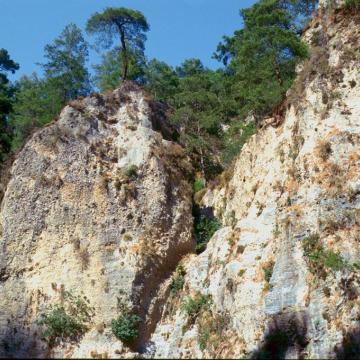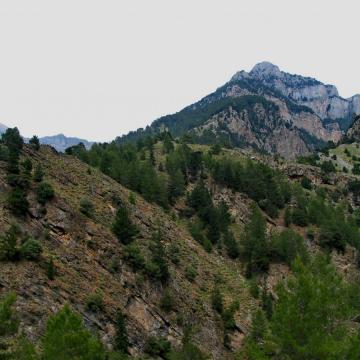GR4340014 - ETHNIKOS DRYMOS SAMARIAS - FARANGI TRYPITIS - PSILAFI - KOUSTOGERAKO
Map
Quality
This is an important site for breeding and passage raptors, and for species characteristic of scrub and montane habitats. Species of concern include: Gypaetus barbatus, Aquila chrysaetos, Falco peregrinus and Pyrrhocorax pyrrhocorax. Samaria gorge is the oldest National Park in Greece. The complexity and the beauty of the site are unique; proof of this fact are the thousands of visitors who come to cross it (circa 150,000 visitors annualy).The National Park is relatively well managed. Undisturbed for a long period, it contains very well balanced and highly diverse plant and animal communities. The National Park is practically the only area where grazing, which is one of the major causes of negative impacts on habitats elsewhere, is forbidden. Field research is necessary in order to document the indications we have about Samaria's gorge importance.OTHER IMPORTANT SPECIES WITH MOTIVATION DPlants: The endemic species Eryngium ternatum, Helichrysum heldreichii, Sanguisorba cretica and Teucrium cuneifoliumare protected by the Greek Law (Presidential Decree 67/81) and included in the IUCN list in the category of threatened plants and in the European Red Book of Globally threatened plants characterized as "rare". Animals: Mustela nivalis is protected by the Greek Law (Presidential Decree 67/81) and by the Bern Convention.. Glis glis argenteus and Meles meles arcalus are included in the National Red Data Book and are protected by the Greek Law (Presidential Decree 67/81) and by the Bern Convention. Martes foina is protected by the Bern Convention.All the reptiles and the amphibian Bufo viridis are protected by the Bern Convention. Bufo viridis, Chalcides occelatus, Lacerta thrineata polylepidota and Podarkis erhardii leukaorii are, also, included in the Directive 92/43/EEC as species of community interest. Hemidactylus turcicus is protected by the Presidential Decree 67/81.
Other characteristics
Geology: The main geological formations composing the geological substrate of the National Park of Samaria Gorge are three: platy crystalline limestones, compact limestones and dolomites, slope debris and fansMain geomorphological and landscape features: The core of the site consists of the approximately 18km long Samaria gorge, directed from the North to the South. The gorge has a unique geomorphology which is characterized by an extremely narrow path, not wider than 3 - 4 m, and by nearly vertical inclines, 300 - 400 m high. The karstic Samaria ravine is of the largest coastal ravines in the Balcans.Further more the site is characterized by:1. A number of secondary ravines beginning from the peaks of Volakias and Avlimonokou and flowing in to the main gorge (in its torrent)2. An impressive altitudinal variation; within 6.5 km the altitude increases from nearly zero to more than 2,100 m a.s.l. and there are 4 peaks exceeding 2,000 m a.s.l.3. Several geological faults which have resulted in characteristic crags reaching up to 300 - 400 m high.4. Characteristic geomorphological elements of the karstic landscape of Crete such as the limestone dolines, caves (most of them being unexplored), formations of slope debris and fans, and several springs.5. Areas with abandoned terraces, a significant human made element of the landscape.The Pinus brutia stands are generally found in the lower elevation zone (0 - 600 m a.s.l. approximately); The formations of Pistacio - Ceratonion do not exceed 200 m a.s.l.; the mixed P. brutia - Cupressus sempervirens stands dominate the altitude zone from 500 - 1,000 m a.s.l. approx. and the pure Cupressus sempervirens stands usually exist between 900 - 1,800 m a.s.l. Above this altitude, important formations of mixed or pure, stands or clusters of C. sempervirens, Quercus coccifera, Acer sempervirens and Zelcova abeticea are quite common, not exceeding 1,600 m a.s.l. At higher altitudes there are formation characterized by Astragalus creticus and Astragalus angustifolius. NOTES 1) The pure Acer sempervirens formations cover a small part of the site. This habitat type is not included in Annex I and corresponds to CORINE code 32.1A.2) The largest area of the site is covered by a mixed forest of pine and cypress.
Documentation
1) Catsadorakis G. 1985. The vertebrate fauna of the White Mountains National Park (Samaria) of Crete. Hania Forestry Serv. 1: 1-46 [3.2, 3.3]
2) Martens, J. 1967 : Plecotus austriacus (Fischer) auf Kreta mit Bermerkumgen zu weiteren Arten (Mammalia, Chiroptera). Bonn.zool.Beitr. 18(3-4) : 253-362 [3.2, 3.3]
3) Mavrommatia G. 1976. Dierevnisis tou oikosystimatos Ethnikou Drymou Samarias, Kriti (Investigation of the ecosystem of Samaria National Park, Crete). [3.2, 3.3]
4) Nievergelt B. & Stocker J. 1986. Lefka Ori (White Mountains), western Crete. Report. Field course for ethnologists and wildlife biologists. Ethnol. Wildlife Res. Inst. Zool. Univ. Zurich-Irchel. 1-93.[3.2, 3.3]
5) Ondrias, J.C., 1965. Die Saugetiere Griechenlands. Saugetierk. Mitt. 13 (3): [3.2, 3.3]
6) Pendarakis C.E. 1994. Structure and dynamics of Pinus brutia var. brutia (Ten.) stands naturally established on abandoned fields, at Anopolis plateau, Southern Crete. Thesis. International Centre for Advanced Mediterranean Studies. Mediterranan Agronomic Institute of Chania, Crete, Greece.
7) Pohle H. 1953. Uber Fledertiere von Kreta Z. Saugetierk 17(1): 14-20 [3.2, 3.3]
8) Sowing. 1985. Beitrage zur Kenntnis der Verbreitung und Oekologie der Amphibien und Reptilien Kretas. Salamandra, 21(4): 252-262 [3.2, 3.3]
9) Strijboch H. 1984. Waarnemig aan de herpetofauna van Kreta. Lacerta 42(4): 61-80 [3.2, 3.3]
10) Vardinoyannis K., 1994. Biogeografia ton cherseon malakion sto notio nisiotiko aigaiako toxo (Biogeography of land snails in the south Aegean arc). Ph.D. Thesis. Univerity of Athens., p. 327 [3.2, 3.3]
11) Wettstein, O. 1935. Herpetologia aegaea. Sber. Osterr. Akad. Wiss. 162:651-833. [3.2, 3.3]
12) Wettstein O., 1953. Die Insectivora von Kreta. Z.Saeugetierk. 17: 413. [3.2, 3.3]
13) Zaffran J. 1990. Contributions a la flore et la vegetation de la Grete. Universite de Provence, p. 650. [3.2, 3.3]
14) Zimmermann K., 1953. Die Wildsauger von Kreta. Z.Saeugetierk 17(1): 1-72. [3.2, 3.3]
15) Dafis S., 1989. The rehabilitation of the degradated forest ecosystems. IUFRO proceedings: Rehabilitation of the degradated forest ecosystems. Chania, Crete, Greece
16) Edenberger J. and Mayer H., 1989. Zypressen - steil - hangwalder in Nationalpak Samaria-Kreta/Griecheland.IUFRO proceedings: Rehabilitation of the degradated forest ecosystems. Chania, Crete, Greece
17) Egli B.R., 1991. The special flora, ecological and edaphic conditions of dolines in the mountains of Crete. Bot. Chron. 10: pp. 325-335
18) Fournaki C., Personal communication (1995)
19) Heath, M. F. and Evans, M. I., eds. 2000. Important Bird Areas in Europe: Priority sites for conservation. 2: Southern Europe. Cambridge, UK: BirdLife International. BirdLife Conservation
Series No. 8, p. 791. 20) Lymberakis P., Personal communication (1995)
21) M.A.I.C.H., Department of aromatic and medical plants, 1994. Catalogue of Cretan endemic plants. Responsible scientists : Fournaraki C. and Kazakis G.
22) Papanastasis V., 1995. Apotelesmata tou erevnitikou programmatos gia ta apeiloumena topia tis Kritis. Results from a research program concerning the threatened landscape of foresters. Hellenic Forestry society, Thessaloniki.
23) Pedarakis K., 1994. Structure and dynamics of Pinus brutia stands, naturally established on abandoned fields, Anopolis plateau, Crete. M.sc. thesis M.A.I.C.H.
24) Georghiou K. 1995. Checklist of Endemic, Rare and Threatened Plants of Greece. Draft. University of Athens. (3.3, 3.4, 4.2)
25) Morgan V & C. Leon. 1992. Datasheets of Flora species for revision of Appendix I of the Bern Convention. Volume IV. endemic taxa of Cyprus, Greece and Turkey Nature and environment. Nature and Envrionment. No 63 p. 106. Council of Europe, Publishing and Documentaion Service, Strasbourg. (3.2.g.)
26) Catsadorakis G. 1991. On the avifauna of Samaria gorgre (Crete, Greece). Kartierung mediterr. Brutvogel 6: 3-12. (3.2. a, b).
27) Economidou E. 1988. Inventory and study of the wetlands and other important bird biotopes in Crete. Final report, Vol. I. University of Patras. Ministry of Environment, Physical Planning and Public Works. Partas. (3.2. a, b).
28) Grimmet R.F.A. & T.A. Jones. 1989. The Important Bird Areas in Europe. ICBP Technical Publication No. 9, p. 906. (3.2. a).
29) [CORINE BIOTOPES] (3.2. a, b).
Reference: Natura 2000 data form, database release 7 Feb 2014






